- Privacy Policy

Home » Delimitations in Research – Types, Examples and Writing Guide

Delimitations in Research – Types, Examples and Writing Guide
Table of Contents

Delimitations
Delimitations in research define the boundaries and scope of a study, outlining what will and will not be addressed. They clarify the choices made by the researcher to focus on specific aspects of the topic, study area, population, or methodology. While delimitations set limits on the study’s scope, they also help improve the clarity, feasibility, and relevance of the research by narrowing down its objectives.
Definition of Delimitations
Delimitations are the intentionally established boundaries of a study that specify its scope and constraints. They outline the choices made regarding the study’s focus, sample, methodology, and timeframe, helping readers understand the study’s limitations and providing context for the findings.
Key Aspects of Delimitations:
- Define the study’s scope and boundaries.
- Explain why certain elements are included or excluded.
- Address factors that may impact generalizability.
For instance, a study on employee motivation might choose to focus only on employees within a specific industry. This choice becomes a delimitation, clarifying that findings may not apply to other sectors.
Types of Delimitations in Research
- Definition : These delimitations specify the target population for the study, such as age group, geographical area, or specific characteristics of participants.
- Example : A study on college students’ social media usage that only includes students from a specific university.
- Purpose : Population delimitations help researchers focus on a specific group, making the study more manageable and relevant.
- Definition : Conceptual delimitations define the study’s focus, including the concepts, variables, or theories the research will examine.
- Example : A study on mental health that examines only depression and anxiety, excluding other mental health disorders.
- Purpose : Conceptual delimitations clarify which aspects of a broader topic are being explored, providing a clear focus for analysis.
- Definition : These delimitations outline the methods and approaches the researcher chooses to use, including data collection techniques, sample size, or research design.
- Example : Using a survey instead of in-depth interviews in a study on job satisfaction.
- Purpose : Methodological delimitations specify the research design choices, helping readers understand the approach taken and its impact on the findings.
- Definition : Instrument delimitations refer to the specific tools, measures, or instruments used in the study.
- Example : Using a standardized questionnaire rather than a customized one to measure employee satisfaction.
- Purpose : Instrument delimitations highlight the constraints imposed by using certain tools, impacting how data is collected and interpreted.
- Definition : These delimitations specify the timeframe for data collection or the period the study covers.
- Example : A study that examines social media trends from 2019 to 2021.
- Purpose : Temporal delimitations limit the scope to a certain period, impacting the study’s relevance and potential for generalization over time.
- Definition : These delimitations confine the study to a specific location or region.
- Example : A study on urban public transportation efficiency limited to New York City.
- Purpose : Geographical delimitations set the study within a particular context, aiding in the relevance and feasibility of the research.
Examples of Delimitations in Research
- A study investigating the effect of physical activity on academic performance may choose to include only high school students from a single district. This population delimitation helps narrow the focus but may limit generalizability to students in other regions.
- Research on customer satisfaction may choose to focus only on customer service quality, excluding factors like product quality and price. This conceptual delimitation focuses on one aspect of satisfaction, simplifying the study’s scope.
- In a study exploring employee motivation, the researcher may choose to use surveys instead of interviews, as surveys allow for data collection from a larger sample. This methodological delimitation impacts the depth of data obtained but enhances the feasibility.
- A study on COVID-19 vaccination attitudes might limit its analysis to data collected between 2020 and 2022, providing a specific timeframe that contextualizes the findings.
Why Are Delimitations Important?
Delimitations are essential in research for several reasons:
- Clarity : They provide clarity on the study’s focus, allowing readers to understand its scope.
- Feasibility : By defining the scope, delimitations make the study manageable within available resources and time constraints.
- Transparency : They communicate the researcher’s choices openly, helping readers interpret the findings accurately.
- Generalizability : Delimitations help define how broadly findings can be applied, addressing potential limitations in the study’s applicability.
How to Write Delimitations in Research
- Clearly state the decisions that limit the study’s scope, such as population, location, and timeframe. Explain why these choices were made to provide context.
- Example : “This study focuses on the role of social media in shaping public opinion in the United States between 2019 and 2021. These delimitations were chosen due to data accessibility and to align with current social trends.”
- Provide a rationale for each delimitation to clarify its purpose. This justification helps readers understand why specific decisions were necessary for the study’s objectives.
- Example : “The study focuses solely on university students to maintain a consistent demographic, as previous research indicates that age can significantly impact social media usage patterns.”
- Recognize the impact of the delimitations on the study’s generalizability. Mention any limitations that readers should consider when interpreting the findings.
- Example : “While the study provides insights into social media use among university students, findings may not be generalizable to older age groups or individuals outside academic settings.”
- Avoid overly broad or vague delimitations. Keep each delimitation clear, specific, and relevant to the study’s objectives.
- Example : “The study investigates customer satisfaction among small business clients in urban areas, as rural customers may have distinct expectations due to geographic factors.”
- In a research paper, delimitations are often included in the methodology or introduction section. Ensure that they are easy to locate and appropriately placed.
- Example : Include delimitations in a subsection titled “Delimitations” within the methodology to clearly separate them from other methodological considerations.
Sample Paragraph for Delimitations
“This study explores the relationship between work-life balance and job satisfaction among employees in the tech industry within the United States. The population is limited to full-time employees aged 25-45 to maintain consistency in work hours and career stages. The study uses an online survey to collect data, as surveys allow for larger sample sizes and more efficient data collection. Additionally, the study is restricted to data collected between January and December 2023 to provide a current snapshot of the industry. While these delimitations narrow the scope of the research, they ensure a focused analysis on specific factors influencing job satisfaction in the tech sector.”
This sample paragraph highlights the study’s delimitations and provides a rationale for each, allowing readers to understand the scope and limitations.
Delimitations in research are essential for defining the boundaries of a study, guiding its focus, and helping readers interpret the findings within a specific context. By understanding and clearly stating delimitations, researchers can ensure transparency and maintain the study’s relevance and feasibility. A well-defined set of delimitations helps both the researcher and readers understand the scope, limitations, and generalizability of the research.
- Creswell, J. W., & Creswell, J. D. (2018). Research Design: Qualitative, Quantitative, and Mixed Methods Approaches . SAGE Publications.
- Kumar, R. (2014). Research Methodology: A Step-by-Step Guide for Beginners . SAGE Publications.
- Flick, U. (2014). An Introduction to Qualitative Research . SAGE Publications.
- Maxwell, J. A. (2013). Qualitative Research Design: An Interactive Approach . SAGE Publications.
- Patton, M. Q. (2015). Qualitative Research & Evaluation Methods: Integrating Theory and Practice . SAGE Publications.
About the author
Muhammad Hassan
Researcher, Academic Writer, Web developer
You may also like

Assignment – Types, Examples and Writing Guide

Research Questions – Types, Examples and Writing...

APA Table of Contents – Format and Example

Appendix in Research Paper – Examples and...

Data Collection – Methods Types and Examples

Research Gap – Types, Examples and How to...
Reference.com
What's Your Question?
- History & Geography
- Science & Technology
- Business & Finance
- Pets & Animals
What Is Delimitation in Research? Examples of Scope & Delimitation

When you’re planning the launch of a study or report, you’ll need to make some important decisions to limit the people you’re researching and the ways you’ll conduct your study. Every credible research study has restrictions and limits in what it covers, and these boundaries are articulated through a research assignment’s delimitations and scope.
Delimitation is the process of drawing boundaries for or fixing the limits of something. Researchers identify and articulate delimitations to explain what their studies will and won’t cover while also defining the methodologies and approaches they’ll use to carry out their studies.
Delimitations help inform the overall scope, which is how deeply a paper, dissertation or study delves into a research question. A scope is the extent of the area or subject matter that something deals with. Often, a well-defined scope addresses the following standard questions:
- Why: What is the point of this research?
- What: What topic is being investigated?
- Where: Where is this research occurring and why?
- When: What is the timeline of this research?
- Who: What are the demographics of the study’s subjects?
- How: What is the methodology of this research (for example, qualitative versus quantitative, which we’ll get into in a bit)?
The key is to explore and clearly define boundaries and barriers on the front end, which will formally become your research study’s delimitations and overall scope. We’ll walk you through how you can identify your study’s delimitations and provide an overview of the important role they play in shaping the overall scope of your research.
Differences Between Limitations and Delimitations
Limitations and delimitations in research both clearly define the boundaries of the research problem that you’re studying. The primary difference between limitations and delimitations comes down to whether the researcher sets the boundaries or those boundaries come from unforeseen factors outside of the researcher’s control.

Delimitations involve a researcher establishing boundaries, whereas limitations are about identifying weaknesses in or barriers to carrying out the study as the researcher originally intended. Limitations disclose what a researcher cannot do (factors outside their control), and delimitations disclose what a researcher won’t do (factors that they chose not to focus on within the scope of the study).
For example, in a study about the impact of arts integration on proficiency levels within an elementary school classroom of 30 students, a limitation may be that the researcher only received parental consent for 25 students to participate. Additional examples of limitations are a lack of previous research on the subject to analyze and work from, a lack of access to the right tools and technology to collect data, and a lack of financial resources to sustain the research. Unlike researcher-defined delimitations, these limitations are initially unforeseen and outside of the researcher’s control.
An example of a delimitation, on the other hand, would be if the researcher opted to focus on third graders and exclude students without special needs from the study. A delimitation tells readers whom the study will cover. In this example, that’s third graders who utilize special education accommodations. The delimitations can also explain how a study is done, which might be through conducting student interviews and an analysis of test results before and after the integration of the arts into the special needs curriculum. Lastly, delimitations provide a picture of where a researcher conducts the study. In the case of this example, the delimitations could include the state, school district and specific school participating in the study.
Examples of Delimitations in Research
Research delimitations can shape and inform a study’s research objectives, methodology, variables and target populations. They can potentially prevent certain outcomes by focusing on sample sizes or population demographics, or they can help in achieving statistical significance. Setting these boundaries helps narrow a researcher’s focus area while increasing the relevance and specificity of the study.

In the example above, the delimitation that narrows the study only to third graders who use special education services ends up removing some potential variables that could impact the outcome of the research. It makes the scope more specific and more relevant. It also opens the door to future research on whether the results are the same for all third graders. Clear delimitations serve research practitioners by defining clear boundaries for what readers and reviewers can expect to find out about in key areas of the study, including where, how and with whom the study is carried out.
Scope and Delimitation in Quantitative Research
Qualitative research involves collecting and analyzing data that aren’t easily reduced to numbers, such as the study of human behaviors or perceptions within specific social environments. Quantitative research, meanwhile, involves collecting numerical data. These data can be helpful in measuring patterns and averages and in testing theories.

In the previous example of a study that reviews arts integration within a classroom, say the scope shifted from measuring changes in average student proficiency levels to measuring student perception of the overall learning experience. This would shift the study from quantitative to qualitative.
Defining the research approach, or the way in which the researcher conducts the study, is a delimitation. In a qualitative research study within an academic environment, a researcher may choose to administer a survey or conduct interviews for data collection around the students’ perceptions of the learning experience. If the study was intended to collect quantitative data as opposed to qualitative, the data-collection approach might instead involve measuring the numeric change in student test scores.
Quantitative research still uses delimitations to explain what the data will reveal and what they won’t. This gives others a reasonable expectation of what your data will explain, how you’ve analyzed it and how accurate your measurements were.
Guidelines in Writing About Scope and Delimitation
You should include a discussion of delimitations in the introduction to your research study, thesis or dissertation. Delimitations, limitations and overall scope are often made through statements like:

- This study covers…
- This study does not cover…
- This study is limited to…
- This study focuses on…
- The following has been excluded from this study…
Once you explicitly state what your delimitations are, you should also clearly list the other options available and the reasons why you did not pursue those alternative approaches. All reasoning should connect back to your research study, outlining the relevance of the study and explaining how and why you narrowed your focus. There’s nothing inherently moral about delimitations; they’re not good or bad, so your tone in writing them should reflect that. This is about being objective and about transparently and explicitly sharing what readers can expect from your research study.
MORE FROM REFERENCE.COM


Community Blog
Keep up-to-date on postgraduate related issues with our quick reads written by students, postdocs, professors and industry leaders.
Scope and Delimitations – Explained & Example
- By DiscoverPhDs
- October 2, 2020

What Is Scope and Delimitation in Research?
The scope and delimitations of a thesis, dissertation or research paper define the topic and boundaries of the research problem to be investigated.
The scope details how in-depth your study is to explore the research question and the parameters in which it will operate in relation to the population and timeframe.
The delimitations of a study are the factors and variables not to be included in the investigation. In other words, they are the boundaries the researcher sets in terms of study duration, population size and type of participants, etc.
Difference Between Delimitations and Limitations
Delimitations refer to the boundaries of the research study, based on the researcher’s decision of what to include and what to exclude. They narrow your study to make it more manageable and relevant to what you are trying to prove.
Limitations relate to the validity and reliability of the study. They are characteristics of the research design or methodology that are out of your control but influence your research findings. Because of this, they determine the internal and external validity of your study and are considered potential weaknesses.
In other words, limitations are what the researcher cannot do (elements outside of their control) and delimitations are what the researcher will not do (elements outside of the boundaries they have set). Both are important because they help to put the research findings into context, and although they explain how the study is limited, they increase the credibility and validity of a research project.
Guidelines on How to Write a Scope
A good scope statement will answer the following six questions:

- Why – the general aims and objectives (purpose) of the research.
- What – the subject to be investigated, and the included variables.
- Where – the location or setting of the study, i.e. where the data will be gathered and to which entity the data will belong.
- When – the timeframe within which the data is to be collected.
- Who – the subject matter of the study and the population from which they will be selected. This population needs to be large enough to be able to make generalisations.
- How – how the research is to be conducted, including a description of the research design (e.g. whether it is experimental research, qualitative research or a case study), methodology, research tools and analysis techniques.
To make things as clear as possible, you should also state why specific variables were omitted from the research scope, and whether this was because it was a delimitation or a limitation. You should also explain why they could not be overcome with standard research methods backed up by scientific evidence.
How to Start Writing Your Study Scope
Use the below prompts as an effective way to start writing your scope:
- This study is to focus on…
- This study covers the…
- This study aims to…
Guidelines on How to Write Delimitations
Since the delimitation parameters are within the researcher’s control, readers need to know why they were set, what alternative options were available, and why these alternatives were rejected. For example, if you are collecting data that can be derived from three different but similar experiments, the reader needs to understand how and why you decided to select the one you have.
Your reasons should always be linked back to your research question, as all delimitations should result from trying to make your study more relevant to your scope. Therefore, the scope and delimitations are usually considered together when writing a paper.
How to Start Writing Your Study Delimitations
Use the below prompts as an effective way to start writing your study delimitations:
- This study does not cover…
- This study is limited to…
- The following has been excluded from this study…
Examples of Delimitation in Research
Examples of delimitations include:
- research objectives,
- research questions,
- research variables,
- target populations,
- statistical analysis techniques .
Examples of Limitations in Research
Examples of limitations include:
- Issues with sample and selection,
- Insufficient sample size, population traits or specific participants for statistical significance,
- Lack of previous research studies on the topic which has allowed for further analysis,
- Limitations in the technology/instruments used to collect your data,
- Limited financial resources and/or funding constraints.

This post explains the difference between the journal paper status of In Review and Under Review.
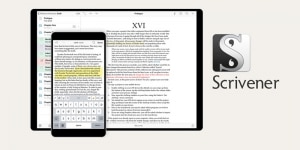
Find out how you can use Scrivener for PhD Thesis & Dissertation writing to streamline your workflow and make academic writing fun again!

The purpose of research is to enhance society by advancing knowledge through developing scientific theories, concepts and ideas – find out more on what this involves.
Join thousands of other students and stay up to date with the latest PhD programmes, funding opportunities and advice.

Browse PhDs Now

A concept paper is a short document written by a researcher before starting their research project, explaining what the study is about, why it is needed and the methods that will be used.

You’ll come across many academics with PhD, some using the title of Doctor and others using Professor. This blog post helps you understand the differences.

Eleni is nearing the end of her PhD at the University of Sheffield on understanding Peroxidase immobilisation on Bioinspired Silicas and application of the biocatalyst for dye removal.

Dr Manning gained his PhD in Chemical Engineering from the University of Sheffield in 2019. He is now a postdoc researcher studying molecular simulations on nanomaterials at the University of Bath.
Join Thousands of Students
- Call for Articles
- Login

Setting Limits and Focusing Your Study: Exploring scope and delimitation
As a researcher, it can be easy to get lost in the vast expanse of information and data available. Thus, when starting a research project, one of the most important things to consider is the scope and delimitation of the study. Setting limits and focusing your study is essential to ensure that the research project is manageable, relevant, and able to produce useful results. In this article, we will explore the importance of setting limits and focusing your study through an in-depth analysis of scope and delimitation.
Company Name 123
Lorem ipsum dolor sit amet, cu usu cibo vituperata, id ius probo maiestatis inciderint, sit eu vide volutpat.
Sign Up for More Insights
Table of Contents
Scope and Delimitation – Definition and difference
Scope refers to the range of the research project and the study limitations set in place to define the boundaries of the project and delimitation refers to the specific aspects of the research project that the study will focus on.
In simpler words, scope is the breadth of your study, while delimitation is the depth of your study.
Scope and delimitation are both essential components of a research project, and they are often confused with one another. The scope defines the parameters of the study, while delimitation sets the boundaries within those parameters. The scope and delimitation of a study are usually established early on in the research process and guide the rest of the project.
Types of Scope and Delimitation
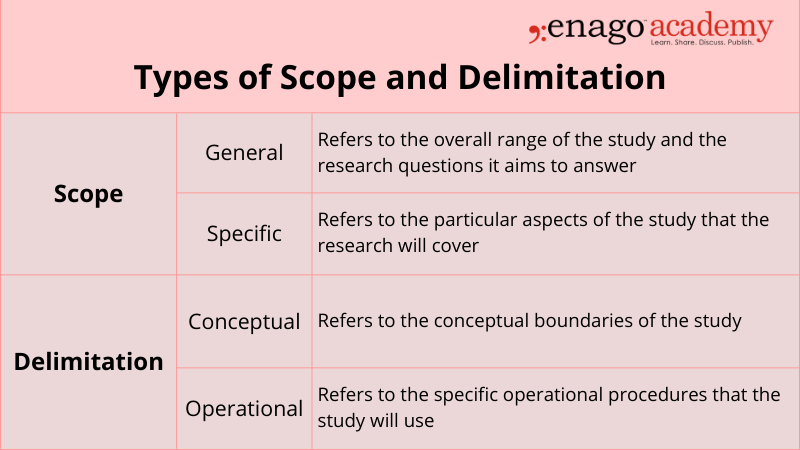
Significance of Scope and Delimitation
Setting limits and focusing your study through scope and delimitation is crucial for the following reasons:
- It allows researchers to define the research project’s boundaries, enabling them to focus on specific aspects of the project. This focus makes it easier to gather relevant data and avoid unnecessary information that might complicate the study’s results.
- Setting limits and focusing your study through scope and delimitation enables the researcher to stay within the parameters of the project’s resources.
- A well-defined scope and delimitation ensure that the research project can be completed within the available resources, such as time and budget, while still achieving the project’s objectives.
5 Steps to Setting Limits and Defining the Scope and Delimitation of Your Study

There are a few steps that you can take to set limits and focus your study.
1. Identify your research question or topic
The first step is to identify what you are interested in learning about. The research question should be specific, measurable, achievable, relevant, and time-bound (SMART). Once you have a research question or topic, you can start to narrow your focus.
2. Consider the key terms or concepts related to your topic
What are the important terms or concepts that you need to understand in order to answer your research question? Consider all available resources, such as time, budget, and data availability, when setting scope and delimitation.
The scope and delimitation should be established within the parameters of the available resources. Once you have identified the key terms or concepts, you can start to develop a glossary or list of definitions.
3. Consider the different perspectives on your topic
There are often different perspectives on any given topic. Get feedback on the proposed scope and delimitation. Advisors can provide guidance on the feasibility of the study and offer suggestions for improvement.
It is important to consider all of the different perspectives in order to get a well-rounded understanding of your topic.
4. Narrow your focus
Be specific and concise when setting scope and delimitation. The parameters of the study should be clearly defined to avoid ambiguity and ensure that the study is focused on relevant aspects of the research question.
This means deciding which aspects of your topic you will focus on and which aspects you will eliminate.
5. Develop the final research plan
Revisit and revise the scope and delimitation as needed. As the research project progresses, the scope and delimitation may need to be adjusted to ensure that the study remains focused on the research question and can produce useful results. This plan should include your research goals, methods, and timeline.
Examples of Scope and Delimitation
To better understand scope and delimitation, let us consider two examples of research questions and how scope and delimitation would apply to them.
Research question: What are the effects of social media on mental health?
Scope: The scope of the study will focus on the impact of social media on the mental health of young adults aged 18-24 in the United States.
Delimitation: The study will specifically examine the following aspects of social media: frequency of use, types of social media platforms used, and the impact of social media on self-esteem and body image.
Research question: What are the factors that influence employee job satisfaction in the healthcare industry?
Scope: The scope of the study will focus on employee job satisfaction in the healthcare industry in the United States.
Delimitation: The study will specifically examine the following factors that influence employee job satisfaction: salary, work-life balance, job security, and opportunities for career growth.
Setting limits and defining the scope and delimitation of a research study is essential to conducting effective research. By doing so, researchers can ensure that their study is focused, manageable, and feasible within the given time frame and resources. It can also help to identify areas that require further study, providing a foundation for future research.
So, the next time you embark on a research project, don’t forget to set clear limits and define the scope and delimitation of your study. It may seem like a tedious task, but it can ultimately lead to more meaningful and impactful research. And if you still can’t find a solution, reach out to Enago Academy using #AskEnago and tag @EnagoAcademy on Twitter , Facebook , and Quora .
Frequently Asked Questions
The scope in research refers to the boundaries and extent of a study, defining its specific objectives, target population, variables, methods, and limitations, which helps researchers focus and provide a clear understanding of what will be investigated.
Delimitation in research defines the specific boundaries and limitations of a study, such as geographical, temporal, or conceptual constraints, outlining what will be excluded or not within the scope of investigation, providing clarity and ensuring the study remains focused and manageable.
To write a scope; 1. Clearly define research objectives. 2. Identify specific research questions. 3. Determine the target population for the study. 4. Outline the variables to be investigated. 5. Establish limitations and constraints. 6. Set boundaries and extent of the investigation. 7. Ensure focus, clarity, and manageability. 8. Provide context for the research project.
To write delimitations; 1. Identify geographical boundaries or constraints. 2. Define the specific time period or timeframe of the study. 3. Specify the sample size or selection criteria. 4. Clarify any demographic limitations (e.g., age, gender, occupation). 5. Address any limitations related to data collection methods. 6. Consider limitations regarding the availability of resources or data. 7. Exclude specific variables or factors from the scope of the study. 8. Clearly state any conceptual boundaries or theoretical frameworks. 9. Acknowledge any potential biases or constraints in the research design. 10. Ensure that the delimitations provide a clear focus and scope for the study.
What is an example of delimitation of the study?
Thank you 💕
Thank You very simplified🩷
Thanks, I find this article very helpful
I really appreciate this
Rate this article Cancel Reply
Your email address will not be published.


Enago Academy's Most Popular Articles

- Promoting Research
Graphical Abstracts Vs. Infographics: Best practices for using visual illustrations for increased research impact
Dr. Sarah Chen stared at her computer screen, her eyes staring at her recently published…

- Publishing Research
10 Tips to Prevent Research Papers From Being Retracted
Research paper retractions represent a critical event in the scientific community. When a published article…

- Industry News
Google Releases 2024 Scholar Metrics, Evaluates Impact of Scholarly Articles
Google has released its 2024 Scholar Metrics, assessing scholarly articles from 2019 to 2023. This…
![what is delimitation in research proposal What is Academic Integrity and How to Uphold it [FREE CHECKLIST]](https://www.enago.com/academy/wp-content/uploads/2024/05/FeatureImages-59-210x136.png)
Ensuring Academic Integrity and Transparency in Academic Research: A comprehensive checklist for researchers
Academic integrity is the foundation upon which the credibility and value of scientific findings are…

- Old Webinars
- Webinar Mobile App
Improving Research Manuscripts Using AI-Powered Insights: Enago reports for effective research communication
Language Quality Importance in Academia AI in Evaluating Language Quality Enago Language Reports Live Demo…
How to Optimize Your Research Process: A step-by-step guide
Choosing the Right Analytical Approach: Thematic analysis vs. content analysis for…
Research Recommendations – Guiding policy-makers for evidence-based decision making
Demystifying the Role of Confounding Variables in Research

Sign-up to read more
Subscribe for free to get unrestricted access to all our resources on research writing and academic publishing including:
- 2000+ blog articles
- 50+ Webinars
- 10+ Expert podcasts
- 50+ Infographics
- 10+ Checklists
- Research Guides
We hate spam too. We promise to protect your privacy and never spam you.
- Plagiarism Checker
- AI Content Detector
- Academic Editing
- Publication Support Services
- Thesis Editing
- Enago Reports
- Journal Finder
- Thought Leadership
- Reporting Research
- Diversity and Inclusion
- Al in Academia
- Career Corner
- Other Resources
- Infographics
- Enago Learn
- On-Demand Webinar
- Open Access Week
- Peer Review Week
- Publication Integrity Week
- Conference Videos
- Call for speakers
- Author Training
I am looking for Editing/ Proofreading services for my manuscript Tentative date of next journal submission:

What features do you prefer in a plagiarism detector? (Select all that apply)

Scope and Delimitation
Ai generator.
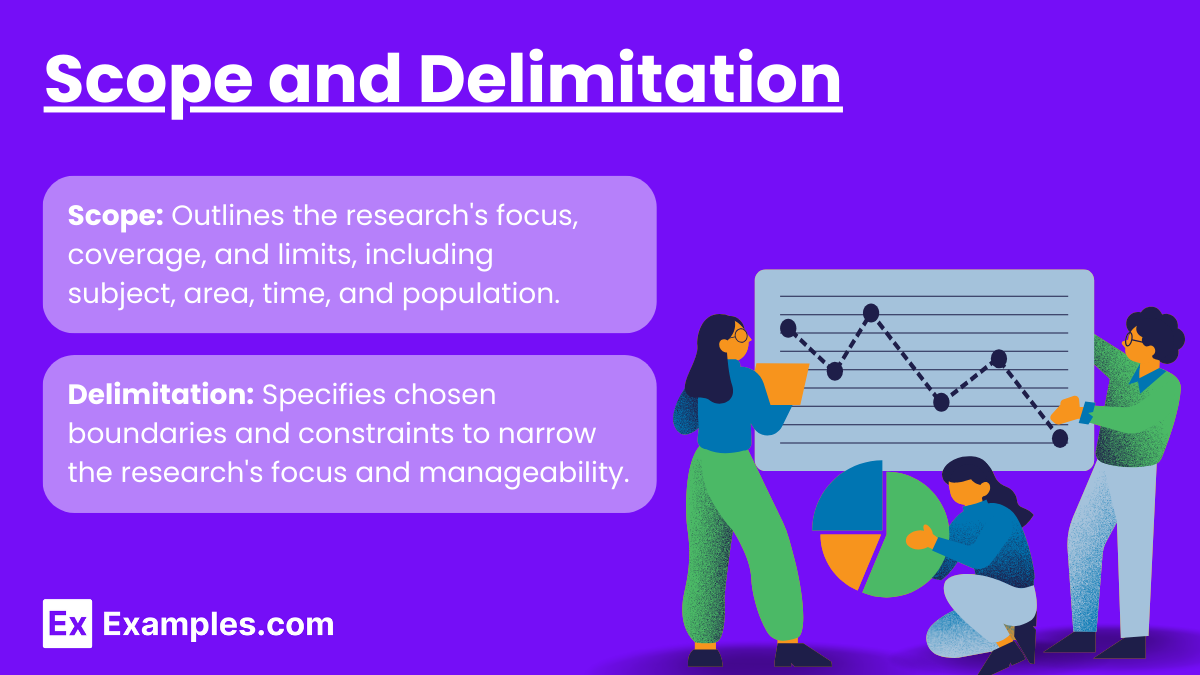
Scope and delimitation are crucial components of a research project, outlining its boundaries and specifying what is included and excluded. The scope details the extent of the study, including its aims, geographical area, time frame, and subjects involved. Delimitations, on the other hand, define the parameters set by the researcher, such as limitations on the scope, methodology, or demographic constraints, helping to focus the research effectively.
What Is Scope and Delimitation?
Scope: The scope of a research project encompasses its objectives, geographical coverage, time period, and subjects or variables studied. It outlines the breadth and depth of the investigation, detailing what the researcher aims to explore or analyze.
Delimitation: Delimitation refers to the self-imposed boundaries set by the researcher within a study. These can include the choice of methodology, theoretical framework, or specific aspects and variables excluded from the research. Delimitations help narrow the focus, making the study more manageable and specific.
Types of Scope and Delimitation
Types of Scope:
- Content Scope: Refers to the range of topics and subtopics that the research will cover.
- Geographical Scope: Defines the physical or virtual locations where the research is conducted.
- Temporal Scope: Specifies the time period during which the data is collected or the events are analyzed.
- Population Scope: Determines the groups, communities, or demographics from which data will be collected.
Types of Delimitation:
- Methodological Delimitation: Involves selecting specific methods or procedures that limit the way data is collected or analyzed.
- Theoretical Delimitation: Focuses the study on a particular theory or set of assumptions, excluding others.
- Data Delimitation: Restricts the range or type of data collected, such as focusing only on qualitative or quantitative data.
- Objective Delimitation: Narrows the research aims and objectives, focusing on specific questions or hypotheses.
Significance of Scope and Delimitation
The significance of scope and delimitation in research is crucial for several reasons:
- Clarity and Focus : Defining the scope helps to clearly establish what the research will cover, ensuring that the study remains focused on relevant questions and objectives. Delimitations further refine this focus by setting clear boundaries, which prevents the research from becoming too broad or vague.
- Feasibility : By setting a realistic scope and appropriate delimitations, researchers can ensure that the project is manageable and can be completed within the allotted time and resources. This makes the study more practical and achievable.
- Validity and Precision : Limiting the scope and delimitations helps in targeting the research more precisely to the area of interest. This enhances the validity of the results as the study avoids extraneous variables and focuses on the key factors.
- Expectation Setting : Both scope and delimitations help in setting the right expectations for the audience or stakeholders. They provide a clear understanding of what the study intends to explore and what it will not address, making the findings more transparent and interpretable.
- Resource Optimization : By clearly defining what is included and excluded in the study, researchers can better allocate resources such as time, manpower, and finances. This optimization prevents wastage of resources on irrelevant or peripheral areas.
Importance of Writing the Scope and Delimitations
Writing the scope and delimitations clearly in a research study is fundamentally important for several key reasons:
- Establishes what the study will cover and what it will not.
- Helps in setting clear objectives and goals for the research.
- Prevents unnecessary expansion of the study, maintaining focus.
- Demonstrates the researcher’s awareness of the study’s limitations.
- Increases transparency, allowing readers to understand the study’s context.
- Acknowledges potential weaknesses, making the research more credible.
- Helps in efficient allocation of time, money, and effort.
- Prevents wastage of resources on areas outside the study’s focus.
- Allows for better planning and execution of research activities.
- Guides the selection of appropriate data sources and methods.
- Ensures data collection remains relevant to the research questions.
- Reduces the risk of collecting irrelevant or excessive data.
- Provides a clear framework for analyzing the collected data.
- Helps in identifying relevant patterns and trends within the defined boundaries.
- Simplifies the interpretation of results, making conclusions more accurate.
- Ensures the research remains aligned with its intended purpose.
- Enhances the applicability of the study’s findings to real-world situations.
- Makes it easier for readers to relate to the study’s outcomes.
- Provides clear guidelines for future researchers to replicate the study.
- Ensures consistency and reliability in research methodology.
- Encourages further exploration within the defined scope.
Difference Between Delimitations and Limitations
Scope and delimitation examples in research.
Here are examples of how scope and delimitation can be defined in different types of research projects:
- Scope : The study focuses on evaluating the effectiveness of a new diabetes management program within urban community clinics over a period of one year. It includes adult patients aged 30-60 who are newly diagnosed with type 2 diabetes.
- Delimitation : The study excludes patients who have been managing diabetes for more than a year or have other chronic conditions, focusing solely on newly diagnosed individuals to isolate the effects of the management program.
- Scope : This research examines the impact of deforestation on river ecosystems in the Amazon Basin, specifically looking at water quality parameters and biodiversity indexes over five years.
- Delimitation : The study limits its analysis to tributaries directly affected by deforestation, excluding regions where industrial pollution might skew the natural impact of tree loss.
- Scope : The project aims to assess the outcomes of a new digital learning initiative on middle school students’ performance in public schools across three states during the current academic year.
- Delimitation : It focuses on public schools that have implemented the program in its entirety, excluding private and charter schools to maintain consistency in educational environment and resources.
- Scope : The research is designed to gather consumer feedback on a new line of ergonomic office chairs, targeting working professionals between the ages of 25 and 45 in the United States.
- Delimitation : The study is confined to online surveys and virtual focus groups, deliberately excluding in-person feedback sessions to expedite data collection and reduce costs.
- Scope : This study explores the influence of the Harlem Renaissance on modern American literature, focusing on the works published between 1920 and 1935 that directly reference or are inspired by this cultural movement.
- Delimitation : The research limits its scope to literary works in English, excluding non-English works and other forms of art like painting or music to concentrate on literary influences.
Scope and Delimitation Examples in Quantitative Research
In quantitative research, where precise measurement and statistical analysis are paramount, clearly defined scope and delimitations are crucial. Here are examples to illustrate how scope and delimitations can be structured in such studies:
- Scope : The study is designed to evaluate the efficacy and safety of a new cholesterol-lowering drug among adults aged 40-65 over a six-month period, using randomized controlled trials across ten different sites in Europe.
- Delimitation : The trial excludes individuals with pre-existing conditions such as diabetes or kidney disease to prevent confounding variables that could affect the drug’s perceived effectiveness or safety profile.
- Scope : This research quantitatively assesses the economic impact of introducing a minimum wage policy in the retail sector within New York City, measuring changes in employment rates and business revenues over two years.
- Delimitation : The study confines its analysis to the retail sector, excluding other sectors like hospitality or healthcare to isolate the specific effects of the wage increase on a similar type of business.
- Scope : The study focuses on comparing standardized test scores between students in charter schools and public schools within the Midwest region of the United States, analyzing data collected over the current academic year.
- Delimitation : It only includes schools that have fully implemented Common Core standards, ensuring that curriculum alignment is maintained across the sample to enhance comparability.
- Scope : This research measures customer satisfaction levels regarding network coverage, customer service, and pricing among users aged 18-55 across the United States.
- Delimitation : The survey targets only current subscribers who have used the service for at least six months, excluding new users to focus on experienced perceptions and reduce the variability brought by initial service impressions.
- Scope : The quantitative study aims to examine the relationship between high-protein diets and heart health in individuals over 50 years old, tracking heart disease markers and overall health outcomes for five years.
- Delimitation : Participants with a history of dietary restrictions or chronic illnesses other than heart-related conditions are excluded to focus solely on the impact of diet on heart health without external medical factors.
Scope and Delimitation Examples about Business
Here are several examples of how scope and delimitation can be defined in business-related research, each tailored to different areas of business studies:
- Scope : This study aims to assess the feasibility and potential profitability of introducing an eco-friendly clothing line in the European market. It analyzes market trends, consumer preferences, and competition within the next two years.
- Delimitation : The research is limited to five major European countries (Germany, France, UK, Spain, and Italy) and excludes other global markets to specifically understand European consumer behavior and regulatory impacts on sustainability.
- Scope : The project focuses on evaluating the impact of remote working on employee productivity within a multinational corporation, utilizing data from productivity software and employee surveys collected over the past year.
- Delimitation : It only considers employees who have been with the company for at least two years to exclude the learning curve effects in new hires and to focus on data reflecting more established work patterns.
- Scope : This research quantitatively examines the factors that influence customer loyalty and retention rates in the online retail sector, focusing on customers aged 25-45.
- Delimitation : The study limits its analysis to customers who have made at least three purchases in the past year to focus on repeat customers rather than new or occasional shoppers.
- Scope : The study aims to benchmark the financial performance of tech startups in Silicon Valley over the last five years, focusing on key metrics such as revenue growth, profit margins, and capital efficiency.
- Delimitation : Only startups that have received Series A funding or beyond are included, excluding early-stage startups without significant funding to ensure the analysis is centered on companies with comparable levels of investment.
- Scope : This study assesses the brand perception of a newly launched luxury watch brand among high-income consumers in North America, using online surveys and social media sentiment analysis collected over the six months following the launch.
- Delimitation : The research targets only high-income consumers (defined as those earning above $100,000 annually) to ensure the feedback and data are relevant to the brand’s target market.
Scope and Delimitation Example about Working Students
1. academic performance.
The Impact of Part-time Employment on Academic Performance Among University Students
This study aims to examine the relationship between part-time employment and academic performance among undergraduate students at public universities in California during the 2023-2024 academic year. It focuses on how working part-time affects students’ GPA, study habits, and overall time management. The study will utilize quantitative data from academic records and surveys to assess these impacts.
Delimitation
The study is limited to undergraduate students who are employed part-time, working between 10 to 30 hours per week. It excludes:
- Graduate students, to maintain focus on the undergraduate experience.
- Students working fewer than 10 hours or more than 30 hours per week, to analyze the impact within a specific range of part-time employment.
- Students from private universities, to ensure consistency in the educational environment and resources available at public universities.
- Non-traditional students (over the age of 25) and those with significant external responsibilities (e.g., caregiving), to minimize variability related to different life stages and commitments.
2. Mental Health and Well-being
The Impact of Part-time Employment on the Mental Health and Well-being of University Students
This study aims to explore the effects of part-time employment on the mental health and well-being of undergraduate students at urban universities in the United States during the 2023-2024 academic year. It focuses on assessing levels of stress, anxiety, depression, and overall life satisfaction among students who work part-time. Data will be collected through standardized mental health surveys and in-depth interviews.
The study is limited to undergraduate students who are employed part-time, working between 10 to 20 hours per week. It excludes:
- Graduate students, to focus specifically on the undergraduate experience.
- Students working fewer than 10 hours or more than 20 hours per week, to analyze the impact within a specific range of part-time employment.
- Students from rural or suburban universities, to ensure consistency in the urban university experience.
- Full-time employed students and those with significant external responsibilities (e.g., caregiving), to reduce variability related to different levels of work commitment and external stressors.
3. Financial Benefits
The Financial Benefits of Part-time Employment for University Students
This study aims to evaluate the financial benefits of part-time employment for undergraduate students at community colleges in Texas during the 2023-2024 academic year. It focuses on how working part-time impacts students’ financial independence, budgeting skills, and ability to cover educational expenses. Data will be collected through surveys and financial records analysis.
The study is limited to undergraduate students aged 18-25 who are employed part-time, working between 10 to 20 hours per week. It excludes:
- Students who are financially dependent on their parents, to assess the impact of part-time work on financial independence.
- Students from private or out-of-state institutions, to ensure consistency in educational costs and available resources at Texas community colleges.
4. Time Management Skills
The Impact of Part-time Employment on Time Management Skills Among University Students
This study aims to investigate how part-time employment influences the time management skills of undergraduate students at universities in New York City during the 2023-2024 academic year. It focuses on evaluating students’ ability to balance academic responsibilities, work commitments, and personal life. The study will utilize quantitative surveys and qualitative focus groups to gather data on students’ time management practices and challenges.
The study is limited to undergraduate students who are employed part-time, working between 15 to 25 hours per week. It excludes:
- Graduate students, to maintain a focus on the undergraduate experience.
- Students working fewer than 15 hours or more than 25 hours per week, to analyze the impact within a specific range of part-time employment.
- Students from universities outside New York City, to ensure consistency in the urban academic and work environment.
- Students who are not enrolled full-time, to ensure that all participants have similar academic workloads.
- Students with significant external responsibilities (e.g., caregiving), to reduce variability related to different levels of non-academic and non-work commitments.
5. Career Development
The Impact of Part-time Employment on Career Development Among University Students
This study aims to investigate how part-time employment during university affects the career development and job readiness of undergraduate students. The research focuses on senior students majoring in business at major universities in the United States, covering the academic years from 2020 to 2023. Data will be collected through surveys and interviews, assessing factors such as professional skills acquisition, networking opportunities, internships, and career aspirations.
The study is limited to senior undergraduate students who have worked part-time jobs related to their field of study for at least one year. It excludes:
- Graduate and first-year undergraduate students, to concentrate on those nearing graduation and entering the job market.
- Students working in unrelated fields, to specifically measure the impact of relevant work experience on career development.
- Students from universities outside the United States, as career development opportunities and job market conditions can vary significantly by country.
- Students who have not worked part-time or have worked less than one year, to focus on the effects of sustained part-time employment.
How to Write Scope and Delimitation
Writing the scope and delimitation of a research study involves clearly defining the boundaries and limitations of your research. Here’s a step-by-step guide on how to write scope and delimitation:
Writing the Scope
- Clearly state what your research aims to achieve.
- Example: “This study aims to investigate the impact of part-time employment on the academic performance of undergraduate students.”
- Describe the topics or variables that will be explored.
- Example: “The study focuses on the correlation between part-time work hours and students’ GPA, study habits, and time management skills.”
- State who will be included in the study (e.g., specific groups, demographics).
- Example: “The research targets undergraduate students at public universities in California.”
- Define the period during which the study will take place.
- Example: “The data will be collected during the 2023-2024 academic year.”
- Mention the location or context in which the study will be conducted.
- Example: “The study is conducted across public universities in California.”
Writing the Delimitation
- Specify what is not included in the study and why.
- Example: “The study excludes graduate students and students working more than 30 hours per week to focus on the undergraduate experience and moderate part-time work.”
- Explain why certain boundaries are set to ensure focus and manageability.
- Example: “The exclusion of graduate students helps maintain a focus on the unique challenges faced by undergraduates.”
- Identify which variables or aspects are not covered and the reasons for their exclusion.
- Example: “Variables such as extracurricular activities and social life are not included to concentrate on academic performance.”
- Mention any methodological limitations and their rationale.
- Example: “The study uses self-reported surveys, which may be subject to bias, but they provide direct insights into students’ perceptions.”
Example of Scope and Delimitation
Research Title The Impact of Part-time Employment on Academic Performance Among University Students Scope This study aims to examine the relationship between part-time employment and academic performance among undergraduate students at public universities in California during the 2023-2024 academic year. It focuses on how working part-time affects students’ GPA, study habits, and overall time management. Data will be collected through quantitative surveys and academic records. Delimitation The study is limited to undergraduate students who are employed part-time, working between 10 to 30 hours per week. It excludes: Graduate students, to maintain focus on the undergraduate experience. Students working fewer than 10 hours or more than 30 hours per week, to analyze the impact within a specific range of part-time employment. Students from private universities, to ensure consistency in the educational environment and resources available at public universities. Non-traditional students (over the age of 25) and those with significant external responsibilities (e.g., caregiving), to minimize variability related to different life stages and commitments.
What is the scope of a study?
The scope defines the boundaries of a study, including the research objectives, targeted population, variables, and the overall extent of the research.
What are delimitations in research?
Delimitations are choices made by the researcher which should define the boundaries of the study, intentionally setting limits on the study’s scope.
Why are scope and delimitation important?
They clarify what the study will cover and what it will not, helping to focus the research and manage expectations.
How do I define the scope of my research?
Identify the main objectives, the geographical location, the timeframe, the variables considered, and the target population.
What’s an example of a delimitation?
Limiting a study to a specific age group or excluding certain variables from analysis due to defined research boundaries.
How detailed should the scope be?
The scope should be detailed enough to give clear boundaries but flexible enough to allow comprehensive exploration of the topic.
Can the scope change during the research?
Ideally, the scope should remain as defined initially; however, unforeseen factors may necessitate slight adjustments.
How does delimitation affect the research outcome?
Delimitations focus the study but may also exclude factors that could provide additional insights, potentially affecting the comprehensiveness of the research.
Should I discuss scope and delimitation in the introduction?
Yes, briefly outline them in the introduction to set clear expectations and boundaries for your study.
What is the difference between delimitation and limitation?
Delimitations are control variables set by the researcher, while limitations are uncontrollable factors that constrain the research.
Text prompt
- Instructive
- Professional
10 Examples of Public speaking
20 Examples of Gas lighting
Scope and Delimitations in Research
Delimitations are the boundaries that the researcher sets in a research study, deciding what to include and what to exclude. They help to narrow down the study and make it more manageable and relevant to the research goal.
Updated on October 19, 2022

All scientific research has boundaries, whether or not the authors clearly explain them. Your study's scope and delimitations are the sections where you define the broader parameters and boundaries of your research.
The scope details what your study will explore, such as the target population, extent, or study duration. Delimitations are factors and variables not included in the study.
Scope and delimitations are not methodological shortcomings; they're always under your control. Discussing these is essential because doing so shows that your project is manageable and scientifically sound.
This article covers:
- What's meant by “scope” and “delimitations”
- Why these are integral components of every study
- How and where to actually write about scope and delimitations in your manuscript
- Examples of scope and delimitations from published studies
What is the scope in a research paper?
Simply put, the scope is the domain of your research. It describes the extent to which the research question will be explored in your study.
Articulating your study's scope early on helps you make your research question focused and realistic.
It also helps decide what data you need to collect (and, therefore, what data collection tools you need to design). Getting this right is vital for both academic articles and funding applications.
What are delimitations in a research paper?
Delimitations are those factors or aspects of the research area that you'll exclude from your research. The scope and delimitations of the study are intimately linked.
Essentially, delimitations form a more detailed and narrowed-down formulation of the scope in terms of exclusion. The delimitations explain what was (intentionally) not considered within the given piece of research.
Scope and delimitations examples
Use the following examples provided by our expert PhD editors as a reference when coming up with your own scope and delimitations.
Scope example
Your research question is, “What is the impact of bullying on the mental health of adolescents?” This topic, on its own, doesn't say much about what's being investigated.
The scope, for example, could encompass:
- Variables: “bullying” (dependent variable), “mental health” (independent variable), and ways of defining or measuring them
- Bullying type: Both face-to-face and cyberbullying
- Target population: Adolescents aged 12–17
- Geographical coverage: France or only one specific town in France
Delimitations example
Look back at the previous example.
Exploring the adverse effects of bullying on adolescents' mental health is a preliminary delimitation. This one was chosen from among many possible research questions (e.g., the impact of bullying on suicide rates, or children or adults).
Delimiting factors could include:
- Research design : Mixed-methods research, including thematic analysis of semi-structured interviews and statistical analysis of a survey
- Timeframe : Data collection to run for 3 months
- Population size : 100 survey participants; 15 interviewees
- Recruitment of participants : Quota sampling (aiming for specific portions of men, women, ethnic minority students etc.)
We can see that every choice you make in planning and conducting your research inevitably excludes other possible options.
What's the difference between limitations and delimitations?
Delimitations and limitations are entirely different, although they often get mixed up. These are the main differences:
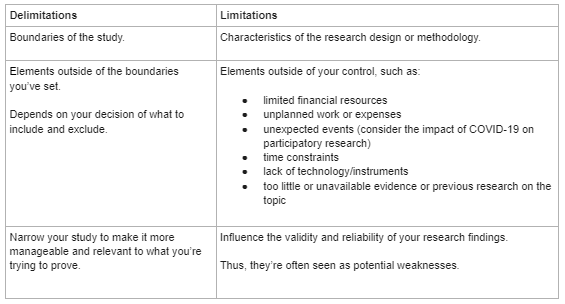
This chart explains the difference between delimitations and limitations. Delimitations are the boundaries of the study while the limitations are the characteristics of the research design or methodology.
Delimitations encompass the elements outside of the boundaries you've set and depends on your decision of what yo include and exclude. On the flip side, limitations are the elements outside of your control, such as:
- limited financial resources
- unplanned work or expenses
- unexpected events (for example, the COVID-19 pandemic)
- time constraints
- lack of technology/instruments
- unavailable evidence or previous research on the topic
Delimitations involve narrowing your study to make it more manageable and relevant to what you're trying to prove. Limitations influence the validity and reliability of your research findings. Limitations are seen as potential weaknesses in your research.
Example of the differences
To clarify these differences, go back to the limitations of the earlier example.
Limitations could comprise:
- Sample size : Not large enough to provide generalizable conclusions.
- Sampling approach : Non-probability sampling has increased bias risk. For instance, the researchers might not manage to capture the experiences of ethnic minority students.
- Methodological pitfalls : Research participants from an urban area (Paris) are likely to be more advantaged than students in rural areas. A study exploring the latter's experiences will probably yield very different findings.
Where do you write the scope and delimitations, and why?
It can be surprisingly empowering to realize you're restricted when conducting scholarly research. But this realization also makes writing up your research easier to grasp and makes it easier to see its limits and the expectations placed on it. Properly revealing this information serves your field and the greater scientific community.
Openly (but briefly) acknowledge the scope and delimitations of your study early on. The Abstract and Introduction sections are good places to set the parameters of your paper.
Next, discuss the scope and delimitations in greater detail in the Methods section. You'll need to do this to justify your methodological approach and data collection instruments, as well as analyses
At this point, spell out why these delimitations were set. What alternative options did you consider? Why did you reject alternatives? What could your study not address?
Let's say you're gathering data that can be derived from different but related experiments. You must convince the reader that the one you selected best suits your research question.
Finally, a solid paper will return to the scope and delimitations in the Findings or Discussion section. Doing so helps readers contextualize and interpret findings because the study's scope and methods influence the results.
For instance, agricultural field experiments carried out under irrigated conditions yield different results from experiments carried out without irrigation.
Being transparent about the scope and any outstanding issues increases your research's credibility and objectivity. It helps other researchers replicate your study and advance scientific understanding of the same topic (e.g., by adopting a different approach).
How do you write the scope and delimitations?
Define the scope and delimitations of your study before collecting data. This is critical. This step should be part of your research project planning.
Answering the following questions will help you address your scope and delimitations clearly and convincingly.
- What are your study's aims and objectives?
- Why did you carry out the study?
- What was the exact topic under investigation?
- Which factors and variables were included? And state why specific variables were omitted from the research scope.
- Who or what did the study explore? What was the target population?
- What was the study's location (geographical area) or setting (e.g., laboratory)?
- What was the timeframe within which you collected your data ?
- Consider a study exploring the differences between identical twins who were raised together versus identical twins who weren't. The data collection might span 5, 10, or more years.
- A study exploring a new immigration policy will cover the period since the policy came into effect and the present moment.
- How was the research conducted (research design)?
- Experimental research, qualitative, quantitative, or mixed-methods research, literature review, etc.
- What data collection tools and analysis techniques were used? e.g., If you chose quantitative methods, which statistical analysis techniques and software did you use?
- What did you find?
- What did you conclude?
Useful vocabulary for scope and delimitations
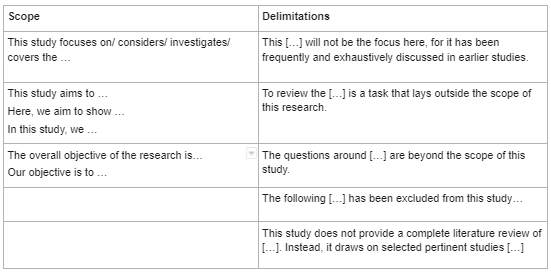
When explaining both the scope and delimitations, it's important to use the proper language to clearly state each.
For the scope , use the following language:
- This study focuses on/considers/investigates/covers the following:
- This study aims to . . . / Here, we aim to show . . . / In this study, we . . .
- The overall objective of the research is . . . / Our objective is to . . .
When stating the delimitations, use the following language:
- This [ . . . ] will not be the focus, for it has been frequently and exhaustively discusses in earlier studies.
- To review the [ . . . ] is a task that lies outside the scope of this study.
- The following [ . . . ] has been excluded from this study . . .
- This study does not provide a complete literature review of [ . . . ]. Instead, it draws on selected pertinent studies [ . . . ]
Analysis of a published scope
In one example, Simione and Gnagnarella (2020) compared the psychological and behavioral impact of COVID-19 on Italy's health workers and general population.
Here's a breakdown of the study's scope into smaller chunks and discussion of what works and why.
Also notable is that this study's delimitations include references to:
- Recruitment of participants: Convenience sampling
- Demographic characteristics of study participants: Age, sex, etc.
- Measurements methods: E.g., the death anxiety scale of the Existential Concerns Questionnaire (ECQ; van Bruggen et al., 2017) etc.
- Data analysis tool: The statistical software R
Analysis of published scope and delimitations
Scope of the study : Johnsson et al. (2019) explored the effect of in-hospital physiotherapy on postoperative physical capacity, physical activity, and lung function in patients who underwent lung cancer surgery.
The delimitations narrowed down the scope as follows:
Refine your scope, delimitations, and scientific English
English ability shouldn't limit how clear and impactful your research can be. Expert AJE editors are available to assess your science and polish your academic writing. See AJE services here .

The AJE Team
See our "Privacy Policy"

IMAGES
COMMENTS
Mar 26, 2024 · Delimitations in research are essential for defining the boundaries of a study, guiding its focus, and helping readers interpret the findings within a specific context. By understanding and clearly stating delimitations, researchers can ensure transparency and maintain the study’s relevance and feasibility.
Apr 19, 2021 · Unlike researcher-defined delimitations, these limitations are initially unforeseen and outside of the researcher’s control. An example of a delimitation, on the other hand, would be if the researcher opted to focus on third graders and exclude students without special needs from the study. A delimitation tells readers whom the study will cover.
‘delimitations’ in biomedical research which in-clude the following: Limitations of any particular study concern poten-tial weaknesses that are usually out of the re-searcher’s control, and are closely associated with the chosen research design, statistical model con-straints, funding constraints, or other factors. In
Aug 30, 2024 · 2. Methodological delimitations. Example: Research using only qualitative methods to explore patients' subjective experiences in a hospital setting. Methodological delimitations specify the research methods (qualitative) that will be employed to gather and analyze data, reflecting the study’s focus on subjective experiences. 3.
Mar 31, 2024 · This meticulous preparation is crucial for defining the scope and delimitations and justifying them within the context of the research proposal or paper. It demonstrates a researcher’s commitment to rigor and depth, showing that their choices are informed by a comprehensive understanding of the subject and its existing body of literature.
Oct 2, 2020 · The scope and delimitations of a thesis, dissertation or research paper define the topic and boundaries of the research problem to be investigated. The scope details how in-depth your study is to explore the research question and the parameters in which it will operate in relation to the population and timeframe.
Jan 22, 2024 · Revisit and revise the scope and delimitation as needed. As the research project progresses, the scope and delimitation may need to be adjusted to ensure that the study remains focused on the research question and can produce useful results. This plan should include your research goals, methods, and timeline. Examples of Scope and Delimitation
Types of Delimitations in Research. The delimitations in the research paper are selected based on various factors determining the research interest before the researchers start their research. Here are some types of delimitation in the research. Geographical Delimitation; It refers to a specific location or area where the research is conducted.
May 17, 2024 · Delimitation: Delimitation refers to the self-imposed boundaries set by the researcher within a study. These can include the choice of methodology, theoretical framework, or specific aspects and variables excluded from the research. Delimitations help narrow the focus, making the study more manageable and specific. Types of Scope and Delimitation
Oct 19, 2022 · Delimitations are those factors or aspects of the research area that you'll exclude from your research. The scope and delimitations of the study are intimately linked. Essentially, delimitations form a more detailed and narrowed-down formulation of the scope in terms of exclusion. The delimitations explain what was (intentionally) not ...